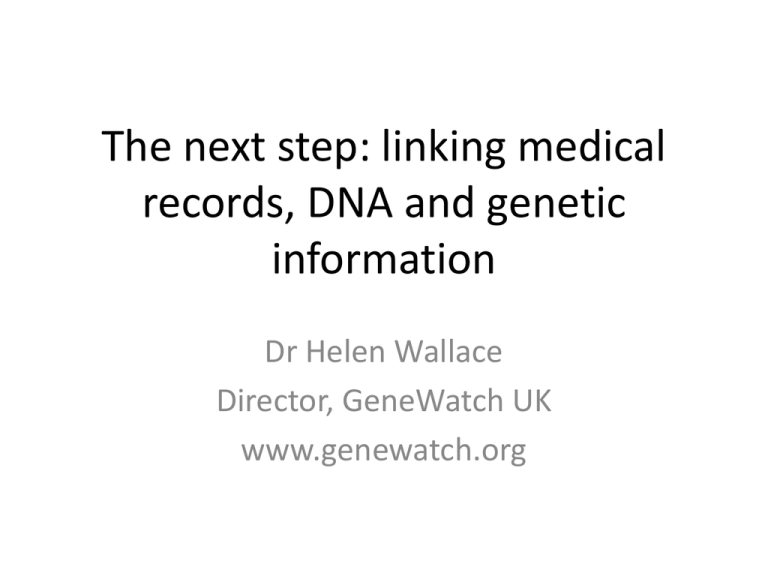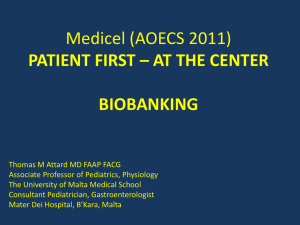
The next step: linking medical
records, DNA and genetic
information
Dr Helen Wallace
Director, GeneWatch UK
www.genewatch.org
Source: Presentation by Tim Hubbard
Source: Tim Hubbard, Wellcome Trust Sanger Centre at
Wellcome Trust Sanger Institute atnd
the
Academy of Medical Sciences, 22
February 2012
Academy of Medical Sciences, 22nd February
2012
This plan is government policy
• Human Genomics Strategy Group (HGSG) report:
National DNA database needed for personalised
medicine drive. The Telegraph. 25th January 2012.
http://www.telegraph.co.uk/health/healthnews/9038712/National-DNA-databaseneeded-for-personalised-medicine-drive.html
• “The [HGSG]report has been welcomed by the
Secretary of State for Health and the Minister for
Universities and Science, who have asked for the
recommendations to be implemented through a
shared strategic framework”. Letter to Genetics
and Ethics from Department of Health, 2012.
What is special about DNA?
• DNA (contained in blood or saliva) can be analysed
to produce a biometric i.e. a permanent link
between your body and any stored data
• Police DNA databases use a DNA profile based on
parts of the (non-coding) sequence (STRs); medical
researchers commonly use 100s to 1000s of SNPs
(single chemical letters that differ between
individuals); or single mutations (rare diseases);
whole genomes include everything.
• Unlike other biometrics, genetic data can also be
used to identify relatives (including non-paternity)
• Genetic data includes (some) information about
health and/or potential to pass recessive genetic
disorders to children
Anonymisation of whole genomes
linked to medical records is impossible
• De-identification can happen by deduction (e.g.
combination of information in other databases)
• Or, someone can collect your DNA from your beer
glass or coffee cup and compare with your
sequence (linked to your medical record) in a
research database
• And/or people working in the NHS may gain nonanonymised access anyway (at the point of care)
or individuals may grant subject access online
(including enforced subject access to insurers)
Collection and processing of DNA
• Processing and storage of DNA by unauthorised
persons without consent is unlawful under the Human
Tissue Act 2004, but the Secretary of State may issue
regulations to allow this for research.
• The Human Genomics Strategy Group and the Academy
of Medical Sciences have argued for amendments to
the HTA that would exempt e.g. saliva from its
provisions.
• Babies’ blood spots are collected with consent for
medical tests at birth: millions are being stored under
guidelines which may allow research use.
• UK Biobank has established a new system of “broad
consent”: 500,000 people have opted in without
knowing who will get access to their data. (However,
only 7% of people invited opted in).
Storage and sharing of genomic data
• Genomes or genotyping of SNP panels (which is
cheaper) will be treated as health data
• Attempts to store and share genome data without
consent will be the same as for e-health records
• Proposed weakening of Data Protection Regulation
in EU would allow use by any “researcher” for any
research or statistical purpose without consent,
and indefinite storage
• Role of DNA as biometric will allow (potentially)
unique (and unbreakable) identification of any
individual and their relatives
The WT/HGSG plan involves
• Complete removal of people’s right to know who is using
their health and/or genomic data for what purpose
(including any conflicts-of-interest) as required by the
Helsinki Declaration
• Construction of a biometric database without consent:
allowing tracking and categorisation of every individual
and their relatives
• A massive reallocation of resources towards collecting
and storing data that is mostly not relevant to a person’s
care
• Abandoning of screening criteria in favour of individual
feedback of personalised risk predictions
• Significant scope for misuse of data for “personalised
marketing” of healthcare products to individuals or their
relatives
The vision
• “…we can now see a future where the doctor will
swab a few cells from inside your cheek, put them
into a DNA-sequencing machine and a computer
will spit out a complete reading of your unique
genetic makeup – all 30,000 or so genes that make
you who you are. From that, doctors could pinpoint
flawed genes and gene products and predict what
diseases you are likely to develop years in advance
of any symptoms – and how to help you avoid
them”. (Tony Blair, ‘Science Matters’ speech, 23
May 2002).
Genetic variants are poor predictors of
common diseases
• “To explore the clinical validity and utility of polygenic
information, studies have been conducted for type 2
diabetes, coronary heart disease, breast cancer, prostate
cancer, multiple sclerosis, and others.23–30 Collectively,
analyses show that the contribution of a combination of
multiple alleles at multiple loci will be limited in
predicting disease for any given individual.…Furthermore,
many of these studies show that adding polygenic
information to risk-prediction models, when available,
provide no or little additional discrimination (as reflected
in analyses of the area under the curve) to current riskprediction models based on traditional risk factors such
as age, body”. Khoury et al. Genetics in Medicine.
advance online publication 14 February 2013
•
“The overall conclusion based on these arguments is
that the predictive value provided by genetic
screening tests for either disease susceptibility or
normal variation will be too low to have widespread
medical or social application”. Wilkie A (2006) Polygenic
inheritance and genetic susceptibility screening. Encyclopedia of Life
Sciences. DOI: 10.1002/9780470015902.a0005638.
•
“Many authors have recently commented on the
modest predictive power of the common disease
susceptability loci currently emerging. However, here
it is suggested that, for most diseases, this would
remain the case even if all relevant loci (including rare
variants) were ultimately discovered.” Clayton, DG (2009)
Prediction and Interaction in Complex Disease Genetics: Experience in Type
1 Diabetes. PLoS Genetics, 5(7): e1000540.
Improving health or sinking costs?
• Whole population becomes market for whole genome
sequencing without any evidence of benefit to health
• Investors in whole genome sequencing cash in
• Taxpayers pay sunk costs (sequencing, infrastructure) and
public provides samples and data (as “duty” to NHS)
• Intermediaries (incl. Google) construct risk algorithms,
which may be used for personalised marketing
• Possible role for technology assessment (NICE) at
feedback stage but this is likely to be over-ruled by “right
to know”
• Screening criteria abandoned (process of weighing up
population benefits and harms)
• Babies and children sequenced without consent
Necessary for public health?
• Supporters of “Public Health Genomics” argue that
storing genomes and allowing data-mining is
necessary for public health
• This is an attempt to undermine Art. 8 of the
European Convention on Human Rights (right to
privacy)
• Public health genetics/genomics was originally
invented by the eugenicists who went to work for
the tobacco industry in the 1950s! Genetic
screening of smokers was supposed to identify the
1 in 10 smokers who got lung cancer in advance so
the rest could “smoke with impunity”. This false
idea was promoted to get funding for the HGP.
Risk predictions will not be reliable or
useful in most cases
• New EU regulations for in vitro diagnostics (IVD)
including gene tests and computer algorithms are
now with the European Parliament: there is no
pre-market assessment of clinical validity or
utility (only quality assurance for the
sequencing).
• This will be used under the US-EU free trade
agreement negotiations to undermine moves by
the US FDA to regulate gene tests as diagnostics.
Whose vision of the NHS?
• The WT/HGSG proposal has been promoted as a
vision for the NHS since at least 1999
• There has never been a public consultation on the
plan
• There has never been an assessment of the costs
and benefits
• There is substantial commercial interest in the plan
as a means to expand the market for healthcare
products (using “personalised marketing” based on
individual risks)
• The idea of genetic screening was originally
proposed by the tobacco industry (later backed by
the food, chemical and nuclear industries) as a
means to undermine public health measures
Who are the lobbyists?
• Sir Mark Walport, new Chief Scientific Advisor,
former head of the Wellcome Trust
• Professor Sir John Bell (Wellcome/Oxford,
Human Genomics Strategy Group, Academy of
Medical Sciences, Office for the Strategic
Coordination of Health Research)
• Sir Richard Sykes (former chair of GSK, Chair of
Imperial College Healthcare NHS Trust)
• Sir Paul Nurse (head of the Francis Crick
Institute and the Royal Society)
• And many others…
Who are the “researchers”?
• Google and its gene test company 23andMe
• Private healthcare companies e.g. GE
Healthcare (investing in “early health”)
• GSK and other big pharma (the drug market is
expected to at least double: Burrill & Co. 2009)
• Food industry (to sell nutraceuticals, functional
foods etc.)
• Your insurer, your employer?
UK Biobank approved
researchers
(also includes academic in
e.g.China)
Other vested interests
• Computer hardware/software/infrastructure
companies (e.g. Microsoft, IBM, cloud
providers)
• Genotyping/gene sequencing companies (Life
Technologies, Illumina/Oxford Nanopore)
• VC investors (may include Wellcome Trust?)
• Universities esp. Oxford, Cambridge and
Imperial (via spinouts, R&D tax credits,
matched PPP infrastructure funding)
Implications
• Access to medical records plus genomes (minus
names) will be “sold” to private companies
• Privacy will no longer exist
• Every individual and their family can be tracked
using their DNA (by the state or others)
• Stigma and discrimination (insurers, employers)
• Personalised risk assessments will be used to
market medication and other products
• Doctors replaced with computers
• Massive expansion in the drug and
“wellness”market; de-skilling in the NHS;
commercial control over diagnosis and prognosis
• Shift from public health controls on
products/pollution/health inequalities to
prevention as “personalised marketing”
Publicly acceptable?
• Only 7% of people approached opted in to UK
Biobank: should 93% be presumed to have given
their consent unless they actively refuse?
• People do not trust the system to keep their data
secure or anonymised and, whilst supportive of
research, want to be asked for their consent
(WT/MRC 2007, CfH 2008)
• There was significant public and professional
opposition to previous attempts to share data
without consent (Clause 152, based on the
Thomas-Walport data-sharing report)
• Retention of innocent people’s data led to
significant loss of public trust in police use of DNA
• Loss of public trust could damage legitimate
medical research
Conclusions
• Data-sharing plans for electronic medical
records are a step on the way to sharing
genomes (and/or genotypes of multiple SNPs)
• This amounts to building a DNA database of
the whole population by stealth in the NHS









